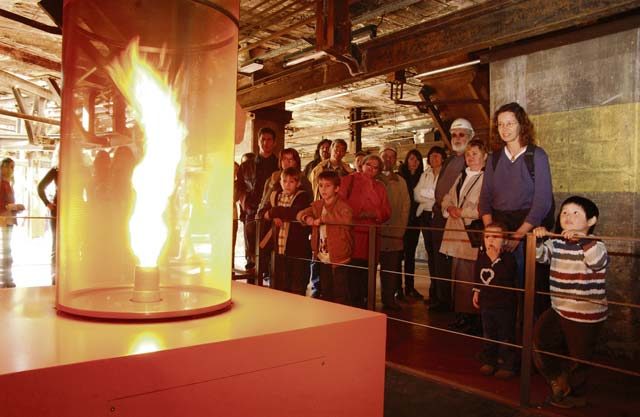
Visitors can watch the fire tornado at the entrance of Feerodrome on the area of Voeklinger Huette.
Voelklinger Huette World Heritage Site is the only fully preserved ironworks of industrial culture. After the closure of the pig iron production in 1986, Voelklingen Ironworks was declared a World Heritage Site by UNESCO in 1994. The beginnings of Voelklingen Ironworks date back to 1873. In 1883, the first blast furnace went into operation. The industrial monument will be preserved for future generations. The World Heritage Site shows outstanding exhibitions on an international level.
The sloping elevator for ore and the sintering plant count as pioneering achievements of Voelklingen Ironworks. The raw materials were transported in a suspension track wagon by the elevator to the charging platform at 32 meters. The charging platform links the six blast furnaces of the ironworks. Sintering technology offers the opportunity to recycle waste products from smelting processes — i.e. ore dust and blast furnace flue dust. Voelklingen is one of the most modern sintering plants in Europe and one of the biggest at the time.
A visit to Voelklinger Huette begins with a multimedia introduction that shows the former day-to-day work. The greatest adventure is to go up to the viewing platform at the blast furnace 45 meters high. From here you have a fascinating view over the industrial landscape of the World Heritage Site.
Where once there were chimneys smoking and a deafening noise was part of everyday work is now a place of concerts and large-scale exhibitions. Industry and culture are combined on an area of more than 600,000 square meters to a must-see attraction for anyone seeking the exceptional.
Apart from the changing exhibitions, the ScienceCenter Ferrodrom® and the Paradise can also be visited. The ScienceCenter Ferrodrom® is a world of experiences on the subjects of iron and steel that links the histories of iron and Voelklinger Ironworks. The process of extracting the iron can easily be understood by kids and adults at over 100 experimental and experience stations.
“The Paradise” is the wild landscape garden at Voelklinger Huette. The area between the plant and River Saar has remained untrod behind an impregnable wall for more than 25 years. Just as in paradise, animals and plants could thrive undisturbed in the shadow of the blast furnace group. With the help of landscape architect Duchess Catherine von Bernadotte, a landscape garden of 33,000 square meters has been created, which stages the dialogue between industrial culture and nature in twelve garden areas.
At one time, vast quantities of ore were stored in the ore shed. Nowadays the ore shed offers a place for exhibitions and cultural events. Voelklinger Huette applies special emphasis on pop culture and pop art. They brought the value of everyday culture to the attention of the general public. Voelklingen Ironworks wouldn’t have been perceived as a World Cultural Heritage Site by UNESCO without the basic change of our culture through pop art. That’s why the site shows important pop art exhibitions of artists like Duane Hanson, Mel Ramos or Allen Jones, located in the ore shed.
The rusty brown walls full of dust and the silos give the shed a rough charm. This makes it a place for extraordinary exhibitions that consciously use industrial culture for its presentation.
The blower hall is the place for the largest exhibitions in the ironworks. These exhibitions often become a strong public attraction. The blower hall spectacularly presents the culture of the Incas, the French cult comic “Asterix” or “Buddha”. With its exhibition area of more than 6,000 square meters, the blower hall was also the place for the most successful exhibition in the history of Saarland: “The Celts — Druids. Princes. Warriors.” with almost 200.000 visitors.
Opening hours are 10 a.m. to 6 p.m. Admission fee is €15. Children, youth under 18, and students up to 27-years-old with students’ ID card are admitted free.
For additional information, visit www.voelklinger-huette.org.


